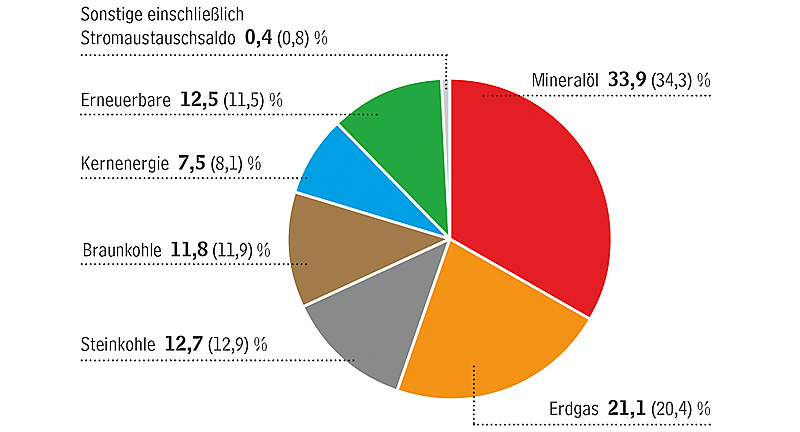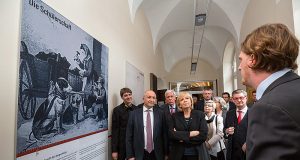Energy consumption in Germany reached 13,306 PJ or 454.0 mt SKE in 2015, constituting a solid 1 % increase on the previous year. The increase is due primarily to the somewhat colder weather in comparison with the previous year, which was very mild, and the associated increase in the demand for heating, states the Arbeitsgemeinschaft Energiebilanzen (Working Group on Energy Balances) in its report on the development of energy consumption in Germany. According to calculations by the AG Energiebilanzen, the positive economic trend and the growth in population also led to an increase in energy consumption; however, this was almost offset by gains in energy efficiency. If you were to discount the effect of the colder weather on increasing consumption, energy consumption would have decreased by 0.4 %, according to the AG Energiebilanzen. In terms of CO2 emissions, the AG Energiebilanzen predicts that there will be only a small weather-based increase in comparison with the previous year, as the increase in consumption related primarily to low-emission or emission-free energy sources and consumption of coal and lignite had fallen (Figure 1).

Fig. 1. Share of energy sources in primary energy consumption in Germany 2015 – 13,306 PJ or 454 mt SKE overall, shares in percent (previous year figures in brackets). // Bild 1. Anteile der Energieträger am Primärenergieverbrauch in Deutschland. 2015 – gesamt 13.306 PJ oder 454 Mio. t SKE, Anteile in Prozent (Vorjahreszeitraum in Klammern). Source/Quelle: AGEB
Consumption of mineral oil in 2015 remained virtually unchanged compared with the previous year, amounting to 4,511 PJ or 153.9 mt SKE. While consumption of diesel fuel increased significantly, principally due to higher demand from the transport and construction sectors, petrol consumption saw a slight decrease, as the number of cars with petrol engines fell. Sales of aviation fuel remained at the same level as last year. An increase in sales of light heating oil failed to materialise owing to consumers choosing to cover their additional needs primarily from their own stocks in spite of lower prices.
Consumption of natural gas rose by 5 % to 2,812 PJ or 95.9 mt SKE. The main reason for this was the colder weather in the first half of the year, in comparison with the previous year which was very mild, and the resultant increase in the use of natural gas for heating purposes. The reappearance of very mild weather in the fourth quarter, however, curbed this increase considerably. 2015 saw a slight decline in the use of coal to 1,691 PJ or 57.7 mt SKE. Roughly two thirds of the total amount of coal consumed in Germany is used to generate electricity. While overall electricity consumption increased and despite very low world market prices for coal, coal usage saw a slight decrease. Turnover generated by the iron and steel industries remained at the same level as last year.
The use of lignite in 2015 fell slightly in comparison with the previous year, going down to 1,567 PJ or 53.5 mt SKE. Around 90 % of lignite production was used in power stations to generate electricity and heat. Electricity generation from lignite also stayed at the same level as the year before, at around 155 TWh.
Nuclear energy saw a decline of about 6 %, which can be attributed to the decommissioning of the nuclear power station in Grafenrheinfeld halfway through 2015.
The contribution made by renewable energy sources rose by almost 10 % overall to 1,669 PJ or 56.9 mt SKE. While the amount of electricity produced from biomass grew by around 2 %, that generated by hydropower (without pumped storage) fell slightly. On-shore and off-shore wind power usage increased by more than 50 % over the previous year. Use of solar energy (photovoltaic and solar-thermal) rose by 7 %, while use of biofuels fell by 6 %. The export surplus for electricity showed a significant increase. Other energy sources – predominantly urban and industrial waste – ended the year on an increase of about 2 %.
In 2015, domestic power generation rose by 1.6 % to 4,131 PJ or 137.3 mt SKE. While the renewable energy sources continued to increase their contribution to domestic energy production, coal and natural gas production in Germany decreased. More than 80 % of domestic power generation is from renewable energy sources and lignite. Overall, domestic energy production covered 31 % of the total consumption in the past year. (AGEB/Si.)


